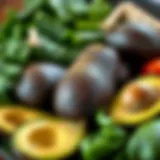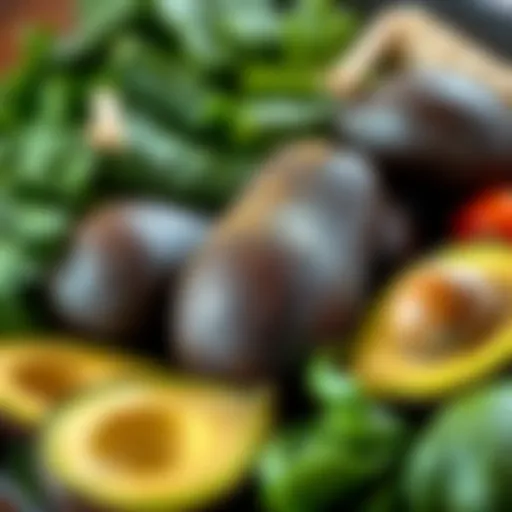Exploring High-Fiber Snacks: A Comprehensive Guide
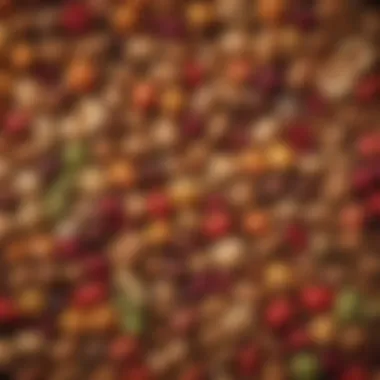

Intro
In the landscape of nutrition, high-fiber snacks have emerged as crucial components for maintaining a balanced diet. Fiber plays a significant role in various aspects of health, from digestion to weight management. In this comprehensive guide, we will explore the multifaceted benefits of high-fiber snacks, providing insights and practical tips for incorporating them into everyday life. Understanding the relevance of dietary fiber is essential, especially for health professionals, wellness coaches, and fitness trainers who aim to support their clients in fostering healthy habits.
Key Benefits
High-fiber snacks provide more than just a sense of fullness. They offer a wide range of physical and mental health benefits that can enhance overall well-being.
Physical Health Benefits
- Supports Digestive Health: Dietary fiber adds bulk to the stool, helping to regulate bowel movements. This can prevent constipation and promote a healthy gut.
- Aids in Weight Management: High-fiber foods are often lower in calories and can increase satiety. This means individuals are less likely to overeat, making fiber-rich snacks effective tools for weight control.
- Helps Regulate Blood Sugar Levels: Fiber can slow down digestion and the absorption of sugar. This leads to better blood sugar control, benefiting those with diabetes or individuals seeking stable energy levels throughout the day.
- Promotes Heart Health: Consuming high-fiber snacks can lower cholesterol levels and reduce the risk of heart disease. Soluble fiber, in particular, is known for its cholesterol-lowering effects.
Mental Well-being Enhancements
- Improves Mood: Recent research suggests that a diet high in fiber may positively impact mood and mental health. Fiber supports the health of the gut microbiota, which is closely linked to mental well-being.
- Reduces Stress: Regularly incorporating fiber into one’s diet can contribute to lower stress levels, fostering a sense of calm in fast-paced life.
"Fiber is not just about keeping your body working smoothly; it’s also about nurturing your mind."
By focusing on high-fiber snacks, individuals can address both physical and mental health, leading to a more holistic approach to nutrition.
Practical Tips
Integrating high-fiber snacks into your daily routine can be straightforward, especially with effective meal planning and mindful choices.
Effective Meal Planning
- Choose Whole Grains: Opt for snacks like whole-grain crackers or oatmeal. These options are rich in fiber and will keep you full longer.
- Incorporate Fruits and Vegetables: Fresh fruits like apples, bananas, and carrots offer natural sources of fiber.
- Experiment with Legumes: Snacks like hummus made from chickpeas or bean-based dip can enhance your fiber intake.
Quick and Efficient Workouts
While this may seem unrelated, being active can complement a high-fiber diet. Aim for consistency rather than intensity. Simple activities such as:
- Taking brisk walks
- Doing quick bodyweight exercises
- Incorporating stretching during breaks
These practices can enhance digestion and overall health, reinforcing the benefits of high-fiber snacks.
This guide aims to empower individuals with knowledge and actionable insights, focusing on the great potential of high-fiber snacks for better health outcomes.
Understanding Fiber
Fiber is an essential component of a healthy diet, aiding in digestion and contributing to overall wellness. It is important to understand the nature of fiber to grasp the benefits it provides, particularly through high-fiber snacks. This section will delve into definitions, types, and the role fiber plays in our digestive system.
Definition of Dietary Fiber
Dietary fiber refers to the parts of plant foods that the body cannot digest. Unlike other food components like fats, proteins, or carbohydrates, fiber remains largely intact as it passes through the digestive system. This characteristic makes fiber crucial for maintaining bowel health and regulating the body's use of sugars. By incorporating fiber into one's diet, individuals can achieve better digestion and support overall health.
Types of Dietary Fiber
Dietary fiber is categorized primarily into two types: soluble and insoluble fiber. Both types play unique roles in health and digestion.
Soluble Fiber
Soluble fiber dissolves in water to form a gel-like substance. This is a key characteristic that underlines its functionality in slowing digestion, which in turn helps in stabilizing blood sugar levels. Foods high in soluble fiber include oats, barley, nuts, seeds, beans, lentils, peas, and certain fruits and vegetables. One substantial advantage of soluble fiber is its ability to lower cholesterol levels, which can reduce the risk of heart disease. However, one potential downside is that too much soluble fiber too quickly can lead to digestive discomfort, so it should be increased gradually in the diet.
Insoluble Fiber
In contrast, insoluble fiber does not dissolve in water. This type of fiber adds bulk to the stool and aids in moving food through the digestive tract. Key sources of insoluble fiber include whole grains, wheat bran, and various vegetables. This fiber type is beneficial for preventing constipation and promoting a healthy digestive system. The unique feature of insoluble fiber is its effectiveness in accelerating the passage of food and waste through the gut. However, individuals need to balance their intake as excessive insoluble fiber might cause bloating or discomfort in some cases.
The Role of Fiber in Digestion
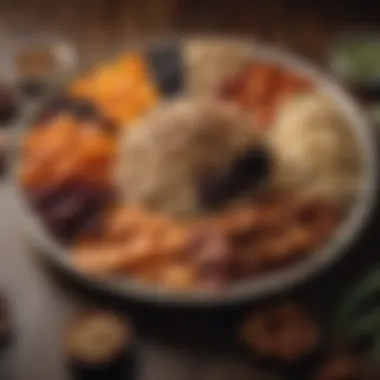

Fiber plays a crucial role in digestion by facilitating a healthy gut environment. It adds bulk to the stool, which helps in preventing constipation and promoting regular bowel movements. Furthermore, fiber assists in maintaining a balanced gut microbiome, which is critical for overall digestive health. A well-functioning digestive system is foundational not only for physical health but also supports mental wellness through the gut-brain connection.
"Adequate fiber intake can significantly enhance digestive health and contribute to achieving a balanced diet."
Health Benefits of Fiber-Rich Snacks
Fiber-rich snacks play a crucial role in a healthy lifestyle. They provide numerous benefits that are backed by scientific research. Consuming these snacks is not just a choice; it's a step towards better overall health. High-fiber snacks contribute to managing weight, improving gut health, and reducing the risk of chronic diseases.
Weight Management
Weight management is one of the significant advantages of incorporating high-fiber snacks into your diet. Fiber takes longer to digest, which helps you feel full longer. This satiety reduces overall calorie intake and may prevent overeating. When foods are high in fiber, they fill you up without adding excessive calories. For example, swapping chips for air-popped popcorn can significantly reduce calorie consumption while still satisfying your crunch craving.
Improved Gut Health
High-fiber snacks support gut health by promoting digestion. Fiber helps regulate bowel movements, preventing constipation. A healthy gut may lead to a stronger immune system and improved mental health. Studies suggest that a fiber-rich diet can enhance the composition of gut microbiota, which plays a crucial role in digestion and overall health. Foods like fruits, vegetables, and whole grains are excellent sources of fiber that can maintain a healthy digestive tract.
Reduced Risk of Chronic Diseases
Eating fiber-rich snacks is linked to a lower risk of several chronic diseases. These conditions can have life-long implications and incorporate both heart disease and diabetes.
Heart Disease
Heart disease remains a leading cause of mortality worldwide. The soluble fiber found in foods like oats and legumes can help lower cholesterol levels. Dietary fiber aids in reducing blood pressure and inflammation, which are risk factors for heart disease. Therefore, including fiber-rich snacks can be beneficial in promoting heart health by managing key risk factors effectively.
Diabetes
The role of fiber in diabetes management cannot be overstated. High-fiber diets may improve blood sugar control and help prevent type 2 diabetes. Foods rich in fiber have a lower glycemic index compared to their low-fiber counterparts, leading to more stable blood sugar levels. This stability is particularly advantageous for overweight individuals at risk for diabetes. Eating whole fruits, vegetables, and whole grains can be instrumental in reducing this risk.
"Incorporating fiber-rich snacks into your diet may not only aid in weight management but also foster gut health and minimize the risk of chronic illnesses."
In summary, the benefits of high-fiber snacks are extensive. They promote satiety, improve digestion, and help ward off severe health issues. For anyone interested in enhancing their wellbeing, making fiber a priority is essential.
Identifying Quality Fiber Sources
Fiber is a crucial element in maintaining a balanced diet. Understanding quality fiber sources is essential for optimizing health benefits associated with fiber. The right food choices can enhance digestion, support weight management, and reduce the risk of chronic diseases. Consuming high-fiber snacks that come from quality sources helps individuals meet their daily fiber intake without compromising other nutritional goals.
Choosing fiber-rich foods from natural sources is beneficial for overall health. Quality fiber sources tend to be less processed and retain a higher nutritional value. Including such sources in the diet can lead to increased satiety, better gut health, and long-term wellness.
Whole Grains
Whole grains are a significant source of dietary fiber. Unlike refined grains, whole grains retain their bran and germ, which contain the bulk of nutrients. Examples of whole grains include brown rice, quinoa, barley, and whole wheat products. A fiber-rich diet incorporating these grains can help regulate blood sugar levels, reduce the risk of heart disease, and aid in digestion. Whole grains provide both soluble and insoluble fibers, making them versatile in different recipes.
It is important to read product labels to ensure whole grains are the first listed ingredient. The inclusion of whole grains in high-fiber snacks can improve their nutritional profile. For example, swapping white bread for whole grain bread can significantly increase fiber content.
Fruits and Vegetables
Fruits and vegetables are paramount in identifying quality fiber sources. They are naturally high in fiber and packed with vitamins and minerals. Consuming a variety of these can enrich the diet and help meet fiber needs. Intaking fruits like raspberries, pears, and apples offers soluble fiber, while vegetables such as broccoli and carrots provide significant amounts of insoluble fiber.
Incorporating fruits and vegetables into snacks not only adds fiber but also increases the intake of antioxidants. Fresh, dried, or in smoothies, these foods can enhance health significantly. A guideline is to aim for at least five servings of fruits and vegetables daily. They can be enjoyed in diverse forms, such as sliced, blended, or as toppings on whole grain options.
Legumes and Pulses
Legumes and pulses are excellent sources of fiber and protein. Foods like lentils, chickpeas, black beans, and split peas are rich in soluble fiber, which promotes digestive health and increases feelings of fullness. Adding these to meals can easily enhance fiber content without excessive calories.
Legumes can be used in a variety of snacks, such as hummus or combined in salads. They are also low in fat and high in important nutrients, making them a smart inclusion in any diet plan. For those looking to increase fiber intake, legumes and pulses are both affordable and versatile.
Nuts and Seeds
Nuts and seeds are often overlooked as fiber sources. Almonds, chia seeds, flaxseeds, and walnuts not only provide healthy fats but also contain a commendable amount of fiber. Including these in snacks helps achieve better dietary balance.
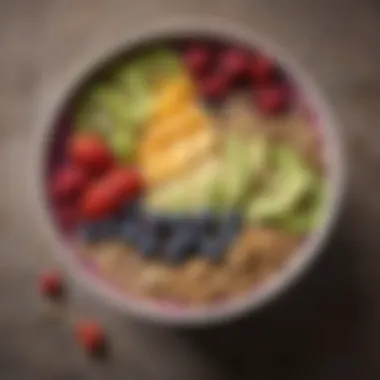

Nuts can be consumed raw, roasted, or as nut butters. Seeds can be sprinkled on yogurt, added to smoothies, or eaten as is. Be mindful of portion sizes, as while nutrient-dense, they are also high in calories. A small handful of nuts or a tablespoon of seeds can greatly contribute to daily fiber intake.
In summary, understanding how to identify quality fiber sources is key to improving diet and well-being. By incorporating whole grains, fruits, vegetables, legumes, and nuts into daily snacks, individuals can increase their fiber intake effectively.
Creative High-Fiber Snack Ideas
High-fiber snacks hold undeniable importance in a balanced diet. They not only improve digestive health but also contribute to maintaining a healthy weight. Fiber-rich foods keep you satisfied longer, helping to prevent overeating. This section presents inventive snack ideas, emphasizing flavors and textures suitable for various preferences. Adding variety in these snacks ensures that individuals remain engaged and invested in healthy eating choices.
Fruit-Based Snacks
Apple Slices with Nut Butter
Apple slices paired with nut butter represent a straightforward yet effective snack option. This combination offers a crisp texture alongside a creamy counterpart. Apples provide soluble fiber, which aids in digestion, while nut butter supplies healthy fats and proteins. Their integration into the diet enhances satiety, making them a popular choice for weight management.
The unique feature of apple slices with nut butter lies in their convenience. They can be prepared quickly and eaten on the go. However, it's essential to be mindful of portions, as excessive nut butter can lead to higher calorie intake. Thus, moderation is key.
Chia Seed Pudding
Chia seed pudding is known for its versatility and nutritional power. Chia seeds, when soaked in liquid, expand, forming a gel-like texture. This unique characteristic contributes to their ability to keep you feeling full, making it an ideal snack choice. Chia seeds are also a great source of omega-3 fatty acids, enhancing heart health.
The pudding can be flavored with various ingredients such as vanilla, cocoa, or fruits, catering to differing taste preferences. Nevertheless, preparing chia seed pudding requires some advance planning, as it needs time to set. Despite this minor inconvenience, the high fiber content remains beneficial for overall wellness.
Vegetable-Centric Options
Carrot Sticks with Hummus
Carrot sticks served with hummus make for a colorful and nutritious snack. Carrots are rich in insoluble fiber, which contributes to significant digestive health. Hummus, made primarily from chickpeas, adds a creamy texture and protein, enhancing the overall snack profile.
This combination is appealing for its crunchy and smooth consistency. It's easy to prepare and transport, which promotes healthier snacking habits at work or school. A consideration with this snack is the sodium content in store-bought hummus, which may be high; hence, homemade versions are a worthwhile option.
Stuffed Bell Peppers
Stuffed bell peppers are a heartier vegetable-centric option. They can be filled with a variety of ingredients like quinoa, beans, or lean meats, creating a satisfying snack or light meal. The key characteristic of this option is its ability to be customized based on dietary needs or preferences.
While stuffed bell peppers may take longer to prepare and cook compared to other snacks, they provide an impressive array of nutrients. Their rich fiber content aids in digestion while the different colors of bell peppers provide a variety of vitamins. Awareness of portion sizes is crucial, especially when filled with calorie-dense ingredients.
Grain-Based Snacks
Popcorn
Popcorn stands out as a classic high-fiber snack. It is a whole grain, making it an excellent source of fiber that promotes digestive health. When prepared without excessive butter or salt, popcorn is low in calories, making it an ideal choice for weight management.
Moreover, popcorn’s light and airy texture allows it to be enjoyed in various flavors, from savory to sweet. Nonetheless, attention must be paid to portion size, as it can be easy to consume large quantities. Air-popped popcorn is a healthier option compared to those laden with fats.
Whole Grain Crackers
Whole grain crackers offer a convenient snacking option that pairs well with numerous dips. These crackers are generally higher in fiber compared to their white counterparts, aiding in proper digestion. Their satisfying crunch further adds to their appeal.
One advantage is the variety available on the market, catering to diverse taste preferences. However, some store-bought options may contain added sugars or unhealthy fats, which must be scrutinized when making selections.
Nut and Seed Mixes
Homemade Trail Mix
Homemade trail mix is a customizable snack that combines nuts, seeds, and dried fruits. This mix provides a balance of protein, healthy fats, and fiber. Nuts like almonds or walnuts offer crunch, while seeds like sunflower or chia add nutritional depth and fiber.
The main advantage of a homemade trail mix is the control over ingredients. This means you can avoid preservatives or excessive sugars found in pre-packaged versions. However, it's essential to monitor portion sizes, as nuts and seeds can be calorie-dense.
Roasted Pumpkin Seeds
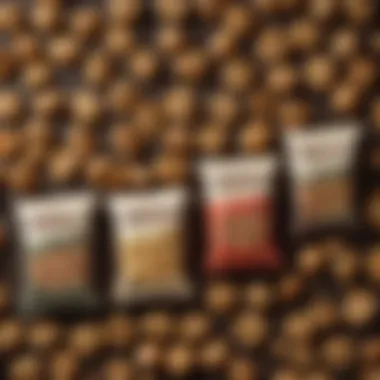

Roasted pumpkin seeds, or pepitas, are a nutrient-dense snack option. They are rich in fiber, protein, and various essential minerals. Their unique nutty flavor makes them an enjoyable snack or addition to other dishes.
The preparation involves rinsing and roasting seeds, allowing for experimentation with different spices. This aspect makes roasted pumpkin seeds a fun and engaging snack to prepare at home. However, they are best enjoyed in moderation, as they can be high in calories if overconsumed.
Creative high-fiber snacks not only make eating healthy enjoyable but also help sustain a long-lasting energy throughout the day.
Incorporating High-Fiber Snacks into Your Diet
Incorporating high-fiber snacks into your diet is a vital aspect of achieving better nutrition and overall health. Fiber is recognized not just for its role in digestion but also for its contributions to long-term wellness. High-fiber snacks help improve satiety, ensuring you feel full longer. This leads to a natural reduction in overall calorie intake, an advantage for those looking to manage their weight. Furthermore, fiber-rich snacks add diverse flavors and textures to your diet, making meals and snacks not only nutritious but also enjoyable.
Timing Your Snacks
The timing of your snacks is crucial. Strategically placing high-fiber snacks throughout the day can help maintain energy levels and prevent hunger. Early in the day, a fiber-rich snack such as oatmeal can provide lasting energy until lunch. After lunch, a fruit like an apple or a pear can keep you from mindless snacking before dinner. Moreover, if you work out during the day, consuming a fiber-packed snack post-exercise supports recovery and enhances nutrient absorption.
Portion Control and Balance
Portion control is essential when enjoying high-fiber snacks. While fiber is beneficial, consuming it in excess, particularly in a short period, can lead to digestive discomfort. Understanding serving sizes can help maintain a balance in your diet. For example, a small handful of nuts or a serving of popcorn can both be satisfying and nutritious. It is often better to combine different types of snacks to avoid monotony and encourage a well-rounded intake of nutrients. Focusing on variety in your diet can make healthy choices easier and more appealing.
Pairing with Other Nutrients
To maximize the benefits of high-fiber snacks, consider pairing them with other essential nutrients. Adding protein or healthy fats to fiber-rich options can further enhance satiety. For example, pair whole-grain crackers with hummus or guacamole, or enjoy fruits with a dab of nut butter. This multipronged approach ensures not just nutritional adequacy but also promotes balanced blood sugar levels. Combining these components can make high-fiber snacks more appealing and satisfying.
"Incorporating high-fiber snacks into your daily routine can positively impact your health and wellness journey."
Challenges in Fiber Consumption
Fiber plays a vital role in promoting health, yet its consumption comes with distinct challenges that can affect individuals’ ability to incorporate it effectively into their diet. Understanding these challenges is critical for anyone aiming to enhance their nutritional intake. By identifying common misconceptions and addressing digestive difficulties, this section aims to equip readers with the knowledge to navigate fiber consumption successfully.
Common Misconceptions
Understanding dietary fiber is essential to dispel the myths surrounding it. Many people believe that all fiber is the same or that consuming more fiber is always beneficial, without realizing that the type and source matter significantly.
- A prevalent misconception is that high-fiber foods automatically lead to weight loss. While fiber can contribute to satiety, not all high-fiber snacks are nutritionally balanced. It’s crucial to assess the overall content of calories, sugars, and fats in these foods.
- Another faulty belief is about fiber causing immediate digestive issues. While some high-fiber foods might cause discomfort initially, especially in those not accustomed to a high-fiber diet, the body needs time to adjust. Gradually increasing fiber intake can alleviate these issues.
- Moreover, some think that a fiber supplement is as effective as real food sources. However, whole foods provide additional nutrients along with fiber that supplements lack.
Being aware of these misconceptions enables individuals to make informed choices and incorporate fiber-rich foods more mindfully into their diets.
Overcoming Digestive Challenges
Digestive challenges are among the most common barriers to fiber consumption. Many people experience bloating, gas, or discomfort when consuming high-fiber foods. Such reactions can deter individuals from including these beneficial items in their meals.
To navigate these challenges, consider the following strategies:
- Start Slowly: Begin with modest amounts of fiber, allowing the digestive system to adjust gradually. Introducing fiber-rich foods incrementally can help reduce discomfort.
- Stay Hydrated: Drinking plenty of water is essential when increasing fiber intake. Fluid helps fiber move through the digestive tract and mitigates issues like bloating and constipation.
- Choose Gradually: Select easily digestible fiber sources first, such as oats or well-cooked vegetables. As tolerance builds, incorporate more complex fibers from legumes or whole grains.
- Listen to Your Body: Pay attention to how your body reacts to different fiber sources. Some individuals may find specific foods more difficult to digest and may need to avoid them for a time.
"Building a high-fiber diet is a process. Listen to your body and adapt your approach as necessary to promote wellness."
By recognizing the importance of addressing misconceptions and digestive challenges, individuals can successfully overcome barriers to fiber consumption. This knowledge empowers one to harness the full benefits of high-fiber snacks, contributing significantly to overall health and well-being.
Final Thoughts on High-Fiber Snacking
High-fiber snacking is a crucial topic worthy of attention in the landscape of nutritional guidance. It encompasses not just the dietary components individuals consume, but also the broader implications of those choices on overall health. Fiber is recognized for its numerous benefits, and high-fiber snacks offer an accessible way to incorporate these advantages into daily routines. As we lead increasingly sedentary lifestyles, finding convenient and healthy snack options can significantly affect our wellness.
Satisfaction and Health
Satisfaction plays a vital role when considering dietary choices. High-fiber snacks often come with the advantage of enhancing satiety. Consuming foods rich in fiber leads to a more prolonged feeling of fullness, thus helping to regulate appetite effectively. For many, this translates into better control over weight management and reduces the temptation to resort to less nutritious options.
Moreover, a balanced intake of fiber improves digestive health. It aids in preventing constipation and promotes regular bowel movements. Fiber-rich snacks can also play a part in maintaining gut health by supporting beneficial bacteria in the intestines, contributing to a more robust immune system. It is essential to consider the link between satisfaction and health when selecting snacks, making fiber a core component of a nuanced dietary approach.
Embracing Variety for Wellness
Incorporating a range of high-fiber snacks can significantly enhance one’s dietary experience. Diversity ensures that individuals do not grow weary of their food choices and continue to enjoy what they consume. Including various fruits, vegetables, legumes, and whole grains in snacking routines dilutes the monotony that can come with repetitive eating patterns.
Besides psychological satisfaction, variety contributes to a comprehensive array of nutrients that aid in overall wellness. Different fiber sources often provide unique health benefits. For instance, fruits carry essential vitamins and antioxidants, while whole grains offer complex carbohydrates that support energy needs. To achieve a well-rounded intake of nutrients, it is wise to embrace this variability.
In summary, high-fiber snacking not only supports digestion and aids in weight management but also enhances overall satisfaction and wellness when approached with variety in mind. This makes it a vital aspect of a healthy lifestyle, encouraging individuals to explore and enjoy the myriad options available.
